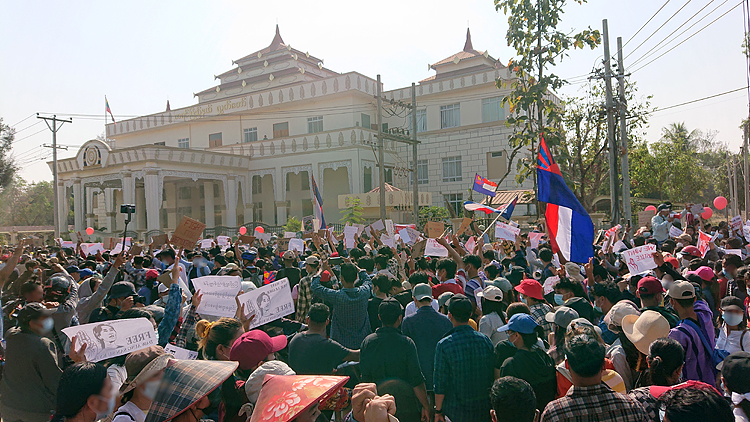INDIAN ARMED FORCES CHIEFS ON OUR RELENTLESS AND FOCUSED PUBLISHING EFFORTS

The insightful articles, inspiring narrations and analytical perspectives presented by the Editorial Team, establish an alluring connect with the reader. My compliments and best wishes to SP Guide Publications.

"Over the past 60 years, the growth of SP Guide Publications has mirrored the rising stature of Indian Navy. Its well-researched and informative magazines on Defence and Aerospace sector have served to shape an educated opinion of our military personnel, policy makers and the public alike. I wish SP's Publication team continued success, fair winds and following seas in all future endeavour!"

Since, its inception in 1964, SP Guide Publications has consistently demonstrated commitment to high-quality journalism in the aerospace and defence sectors, earning a well-deserved reputation as Asia's largest media house in this domain. I wish SP Guide Publications continued success in its pursuit of excellence.
The Spillover from Myanmar
India to navigate the complex North-east region's dynamics urgently and address the growing challenges emanating from Myanmar's unrest
 |
The Author is former Chief of Staff of a frontline Corps in the North East and a former helicopter pilot. He earlier headed the China & neighbourhood desk at the Defence Intelligence Agency. He retired in July 2020 and held the appointment of Addl DG Information Systems at Army HQ. |

While the world's attention is rivetted on the much-anticipated truce in Gaza and the exchange of prisoner-hostage swap, India again stares at instability and a potential refugee crisisbrewing in the North East. The developments in Myanmar come just when the country was heaving a sigh of relief as violence in Manipur was tapering down though it wasn't a return to normalcy. Since late October, in Shan State of Myanmar located in its northeast bordering China, Laos and Thailand andbest known as one of the world's biggest producers of illicit narcotics and lately hosting multitudes of casinos and scam centres, three ethnic insurgent armies called Brotherhood Alliance have overrun dozens of military posts, and captured border crossings and the roads carrying most of the overland trade with China.Operation 1027 - so-called because it was launched on October27, is the most serious setback suffered by the Myanmar's military junta since it seized power in February 2021.
India's Exposed Eastern Flank
In an earlier op-edit titled "India's Exposed Eastern Flank" dated July 8, 2023, two key issues that afflicted Manipur, viz. state action against drug cartels and the vexed Scheduled Tribe (ST) status for the Meitei community were put under the spotlight for the flareup that had begun on May3, 2023. These two issues were the immediate triggers for the situation boiling over then, with a nefarious design to throw out the BJP government in the state which failed. The other constants that ensnare the North East are the proximity to the Golden Triangle, the tribal affinities across the open porous borders, the 55 odd camps operated by Indian Insurgents Groups (IIGs) across in the neighbouring Sagaing and Chin states exploiting the near absence of Tatmadaw (Myanmar's Army) which has just two regiments in the entire 1700 kms long border and the nefarious activities by the Chinese to ferment trouble for India.
Ethnic insurgent armies, collectively known as the Brotherhood Alliance, have overrun military posts in Myanmar, captured border crossings and disrupted overland trade with China in Shan State
Myanmar has been blighted by conflict and poverty since independence in 1948, fragmented into the fiefdoms of different warlords, drug bosses or ethnic rebels who have been fighting each other and the army. The brief dalliance with democracy ended in 2021 coup with the ousted parties forming a National Unity Government (NUG) and seeking help from these very toxic rebel groups.
Exodus from Myanmar
Heavy fighting between the rebels and the Myanmar military in the Chin state across the border from Mizoram and airstrikes by the Tatmadaw saw some 5,000 refugees including from the Tatmadaw who deserted or were made to flee by the rebels entering India. As the fighting thawed, some of the refugees returned back.Around 25 soldiers were rounded up, put on an aircraft and flown back to Naypyidaw. It must be noted that the Chin people are cousins of the Chin Zo -Kuki, Mizo, Lushai, or Naga who speak the Kuki-Chin languages and inhabit areas of India, Myanmar and the Chittagong hill tracts of Bangladesh. Most of these rebel groups get funding and arms from China, not only to checkmate the Tatmadaw but also to frustrate the Indian government's efforts to sniff out the long running insurgency and bring development to the region. This is further complicated or rather facilitated by the 16 kms Free Move Regime on both sides of the border agreed to in 1965 helping the insurgents to disengage from the pursuing police or the paramilitary.
Heavy fighting in Chin state leads to 5,000 refugees, including Tatmadaw personnel, entering India
Dynamics of India's North-East Region
The extremist associations run their very own administration conspicuously known as Under-Ground (UG) governments, which are pretty much parallel to the elected governmentsand extort money from the people in the form of tax. For instance, the Federal Government of Nagaland is the government of the NSCN-IM (Nagaland Socialist Council of NagalandIsak-Muivah), the jurisdiction of NSCN-IM stretches out not exclusively to Nagaland but to all Naga-populated areas in the northeast, including Manipur. When confronted with resolute state authority, they make endeavours to topple the democratically chosen government as witnessed in Manipur pitting the Kukis against the Meitei with the Nagas watching gleefully from the sidelines.

Manipur, a gateway to Southeast Asia, becomes a fulcrum for anti-India activities due to cultural, economic, and infrastructural significance
Manipur as a gateway to Southeast Asia shares contiguity not only in terms of region, also in culture, customs, and food habits, and is all around connected by the Imphal International Airport. Manipur was the linchpin of India's 'Act East Policy', connecting through the Imphal – Moreh – Tamu highway to Southeast Asia. A railway project is also being rapidly built to further help industries to come up in Manipur and boost our trade, transit and connectivity. Hence Manipur becomes the fulcrum for anti-India activities by forces inimical to India.
India's Regional Challenges
Let's take a sweep of our neighbourhood to understand the near isolation that confronts India in South Asia. To the west is the terror fountainhead Pakistan and a medieval Taliban controlled Afghanistan. Nepal is under a communist regimethat takes its orders from Beijing since 2008 when country's centuries-old monarchy was abolished. Tiny Buddhist Kingdom of Bhutan intermittently sends out signals by restarting bilateral border talks with China. Bangladesh remains a hotbed of ISI sponsored jihadi activities though the Sheikh Hasina government has been trying its level best to keep them under check. A debt-ridden Sri Lanka is obliged to China and continues to test India by entering into even more infrastructure building projects with China and permitting their so-called survey (intelligence gathering) ships to dock in the Hambantota port ignoring Indian protests. The newly elected pro-China Maldives President Mohamed Muizzu, has requested India to withdraw its military from the country who operate its helicopter fleet gifted by it though India remains the first responder to the archipelago in case of any disaster or crisis there.
To counter the rebel groups,India needs to collaborate with Myanmar's Tatmadaw despite its pariah status for the West
Given this outlook, it is crucial for India to work with the Tatmadaw notwithstanding its pariah status for the west while in principle it may look politically correct and woke to support the NUG. Since the mid-June 2021 Galwan clashes, tens of thousands of additional Indian Army troops are deployed in the high altitudes of Eastern Ladakh and in Arunachal Pradesh to keep vigil. A vacuum has been created in the Northeast where for decades the Army was deployed alongside the Assam Rifles to keep the foreign-inspired narco-funded insurgency under control. The fresh upheaval by the rebel groups in Myanmar which are well armed with tens of thousands of fighters challenging the Tatmadaw's fragile hold over Myanmar has potential to destabilise an otherwise calm North East India.





